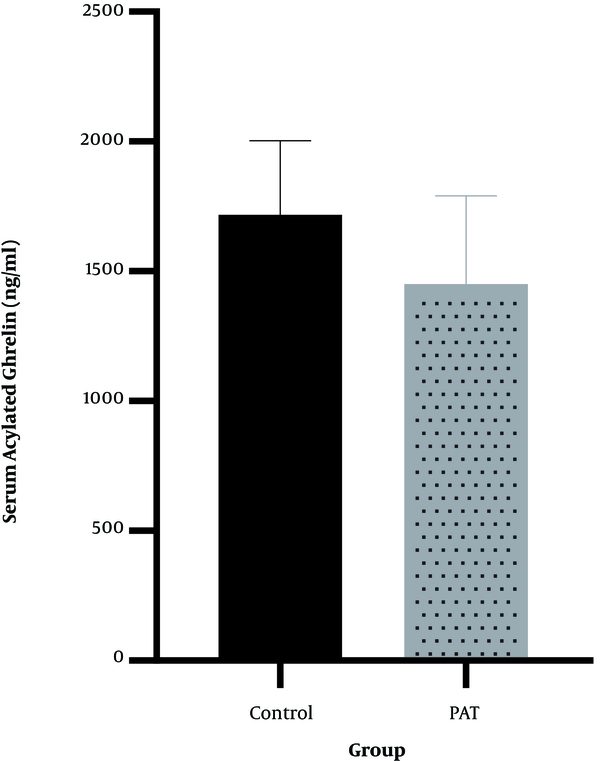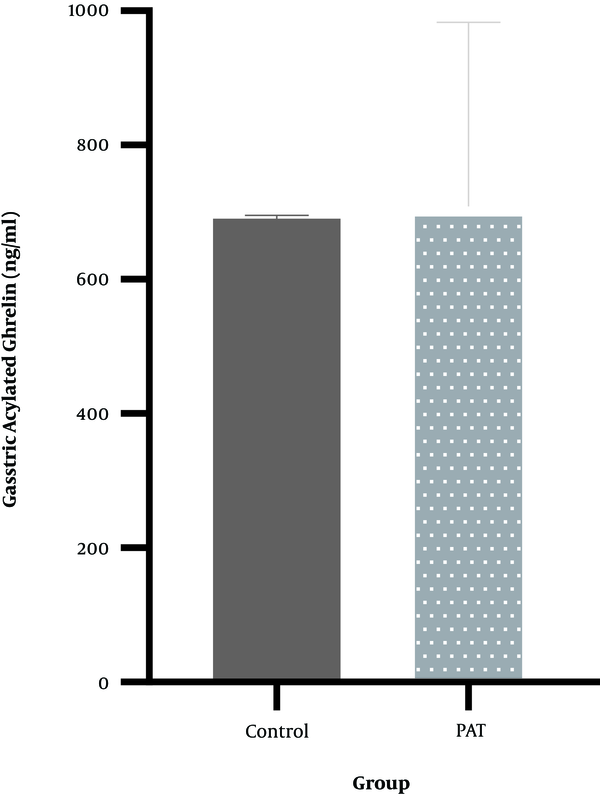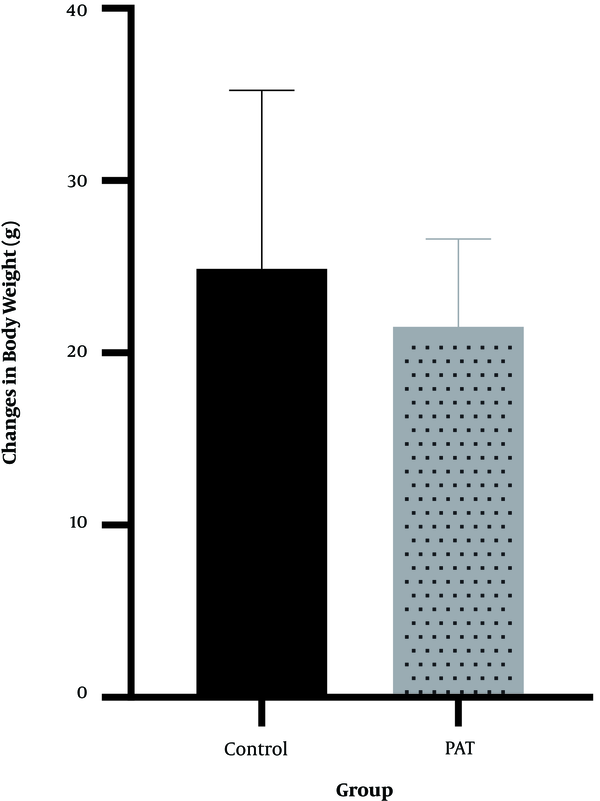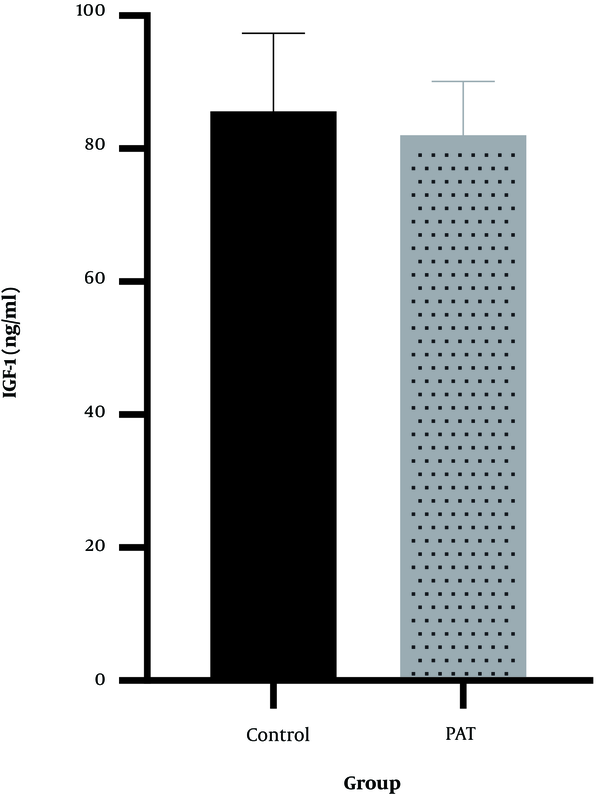Abstract
Background:
It is generally believed that physical activity can lead to increased food intake, whereas some studies state that exercise can have inhibitory effects on appetite and calorie intake.Objectives:
The purpose of this study was to examine the changes in the level of gastric and serum ghrelin, body weight, and serum IGF-1 after a period of progressive aerobic training (PAT) in female rats.Methods:
After one week of familiarization with treadmill running, 16 adult female rats were randomly assigned to two groups: control (n = 8) and aerobic exercise (n = 8). The exercise protocol consisted of progressive aerobic running on the treadmill for three months (5 days a week). Forty-eight hours after the last exercise session, the animals were sacrificed. Serum levels of ghrelin, IGF-1, and ghrelin content in the gastric tissue were measured using the ELISA method. An Independent t-test was used for comparison of data between the two groups.Results:
The results indicated that three months of PAT had no significant effect on gastric (P = 0.51) and serum acylated ghrelin (P = 0.15), weight changes (P = 0.42), and serum IGF-1 (P = 0.56) compared to the control group.Conclusions:
Three months of PAT in female animals had no effects on ghrelin level, food intake and weight loss, and serum IGF-1 level. It seems that there are sex-specific hormonal and appetite responses to progressive aerobic training.Keywords
Physical Aerobic Training Ghrelin Weight Trajectory Insulin-Like Growth Factor 1
1. Background
Understanding the relationship between exercise, appetite, and weight management is necessary for sportsmen and women desiring to enhance their sports performance. Gut hormones (e.g., ghrelin) are potent regulators of appetite influenced by exercise (1). Moreover, appetite and food intake may be affected by factors such as sex (male or female) (2). Examination of exercise intensity on appetite-regulating hormones has only been investigated in highly-trained males (1). However, no report about the effect of progressive aerobic exercise training on the appetite-regulating hormone in females. Suppression appetite and subsequent food intake restriction in female athletes is higher than that of non-athletes and in those with Amenorrhea compared to normal menstrual (3, 4). Besides, energy reduction in female athletes can lead to a reduced IGF-1 level (5), performance decline (6), the prevalence of Amenorrhea (7), low energy availability, menstrual dysfunction, and decreased bone mineral density (4, 8). The mechanisms by which exercise suppresses appetite temporarily are not fully understood but may involve a reduction in ghrelin concentration (2). Ghrelin is a 28-amino acid peptide, which is mainly secreted from the stomach and leads to an increase in appetite and secretion of growth hormone (9). Two types of ghrelin (Acylated Ghrelin and Des-acyl Ghrelin) have been identified in the circulatory system, named total ghrelin (9). Des-acyl Ghrelin cannot affect appetite (10). So, it seems that the assessment of total ghrelin is not a precise index for appetite. It has been suggested that the measurement of acylated ghrelin could be a more accurate method (11, 12). Some studies have shown that serum levels of acylated ghrelin reduce after endurance running and resistance training (13, 14). Recently, Gorzi et al. (15) reported a decrease in acylated ghrelin in the stomach tissue after strenuous interval exercises. However, Haghshenas et al. (16) demonstrated that eight weeks of endurance training had no effects on the plasma levels of acylated ghrelin. On the other hand, Rashidlemir et al. (17) showed that eight weeks of aerobic training in young men increased acylated ghrelin and decreased plasma growth hormone levels significantly. Similarly, 12 weeks of high strenuous training increased acylated ghrelin levels in rats (18). Also, eight weeks of aerobic training at 65% - 68% of maximum heart rate increased ghrelin concentration of healthy females (19). On the other hand, the suppression of ghrelin secretion after exercise can lead to appetite decline and reduces food intake. This decrement over a long-time period would cause negative energy balance and subsequent body weight loss (2). There are controversial reports about the effect of exercise on appetite (2, 7, 13, 14, 16, 18, 20-25) and some closely related topics, such as a change in IGF-1 (5, 26-28), inadequate food energy, and negative energy balance (2), especially in menstrual conditions (4).
2. Objectives
Therefore, the purpose of this study was to investigate the effect of long-term endurance running on gastric tissue and serum acylated ghrelin, the serum level of IGF-1, and weight changes in female rats.
3. Methods
3.1. Animals
Female Wistar rats (200 - 220 g) were purchased from the Pasteur Institute of Iran. They were placed on a 12/12-h light-dark circuit in a temperature (23 ± 2°C), and humidity (%45 ± 5) controlled room. Food and water were provided ad libitum. All rats initially were familiarized with running on the treadmill at the speed of 5 m/min for 10 minutes in the first week. After the acclimation period, to control the intervening variables such as menstrual cycle synchronization and body weight differences, animals were randomly assigned to two groups (control and PAT, n = 8).
3.2. Aerobic Exercise Protocol
The exercise training was performed on a motorized treadmill. The training program consisted of 12 weeks of aerobic running (Five sessions per week at 8 AM - 10 AM). The progressive aerobic exercise on the treadmill started at 13 m/min for 15 min with a zero-degree slope in the first week and reached up to 25 m/min for 55 min in the fourth week (16). This exercise program lasted for eight weeks. Each training session included warming up (5 min at the speed of 10 m/min), main program (duration up to 55 min at the speed of 10 - 25 m/min), and cool down (5 min at the speed of 10 m/min), respectively (29).
3.3. Ethical Considerations
All experimental procedures were under the guidelines for the care and use of laboratory animals published by the National Institute of Health (NIH) and approved by the Animal Ethics Committee of the University of Zanjan.
3.4. Blood and Tissue Sampling
The rats were sacrificed 48 hours after the last training session to rule out the acute effects of exercise. Blood samples were taken from their heart and centrifuged for 10 min with 3000 rpm. Also, the stomach was dissected, and the fundus that has high ghrelin hormone levels was removed to measure ghrelin (30, 31). The samples were washed in the saline solution and immediately frozen in liquid nitrogen and stored at -80°C until laboratory measurements. The tissues were homogenized in PBS buffer. The homogenate was centrifuged for 15 min at 3,000 rpm, and its supernatant was used to measure the ghrelin (15).
3.5. Measurement of Serum and Gastric Acylated Ghrelin and Serum IGF-1 Levels
The concentration of serum and gastric acylated ghrelin hormones were measured using ELISA specific kits for rats (ECPlaza Co., Bioassay TL, China); based on the kit manufacturer's guideline (kit sensitivity was 0.05 ng/L). IGF-1 was measured by the ELISA method using the China Bioassay Laboratory Kit with a sensitivity of 1.55 ng/mL.
3.6. Data Analysis
All results were expressed as mean ± standard deviation (SD). Normality was verified using the Shapiro-Wilk normality test. After ensuring the normal distribution, the independent t-test was conducted to assess the difference between the two groups. The significance level was set at P < 0.05. All statistical analyses were performed using SPSS (version 16).
4. Results
4.1. Serum Acylated Ghrelin
The results indicated that 12 weeks of PAT (1450.3 ± 341.1) had no significant effect on serum acylated ghrelin (P = 0.15, t = -1.54) compared with the control group (1716.8 ± 286.5). The results are fully described in Figure 1.
Comparison of changes in serum acylated ghrelin level (M ± SEM) in the studied groups after 12 weeks of aerobic training.

4.2. Gastric Tissue Acylated Ghrelin
The results indicated that 12 weeks of PAT (708.6 ± 274.0) had no significant effect on gastric tissue acylated ghrelin (P = 0.51, t = 0.686) compared with the control group (690.25 ± 85.7). These results are shown in Figure 2.
Comparison of changes in gastric tissue Acylated Ghrelin level (M ± SEM) in the studied groups after 12 weeks of aerobic training.

4.3. Weight Changes
As shown in Figure 3, twelve weeks of PAT (21.50 ± 5.12) had no effects on weight changes (t = -0.825, P = 0.42) compared with the control group (24.87 ± 10.37).
Comparison of changes in body weight (M ± SEM) in the studied groups after 12 weeks of aerobic training.

Also, feed intake was measured. There were no significant differences in the mean food consumption between the control (676 ± 118 g) and PAT (675 ± 111.02 g) groups.
4.4. Serum IGF-1
The results showed that 12 weeks of progressive aerobic exercise (82.0 ± 8.1) had no effects on serum IGF-1 (P = 0.56, t = -0.598) compared with the control group (85.6 ± 11.8) (Figure 4).
Comparison of changes in serum IGF-1 (M ± SEM) in the studied groups after 12 weeks of aerobic training.

5. Discussion
The results indicated that 12 weeks of PAT had no significant impact on body weight, gastric acylated ghrelin, serum acylated ghrelin, and IGF-1. Reduction in acylated ghrelin following exercise has been reported by some studies (13, 14). Although ghrelin levels decrease after exercise, its effects persist up to several hours following exercise and can lead to a reduction in appetite. Consequently, this causes a negative energy balance and loss of body weight (2). Hence, it seems that the results of this study are substantial; As they show that appetite hormones such as acylated ghrelin are not efficiently reduced due to a relatively long period of PAT.
Our results are inconsistent with the findings of Hagshenas et al. (16), who observed a significant reduction in the weight of the male rats following an exercise program. Similarly, some studies have shown that appetite suppression occurs after moderate to high-intensity exercise (32, 33). In contrast, Fathi et al. (18) reported that high-intensity exercise increases acylated ghrelin, which is also inconsistent with the results of the present study. Despite the high-intensity exercise in this study, there was no increase in acylated ghrelin levels. The main difference between the current research and other studies is the implementation of female rats instead of male ones. It seems that the response of female rats to high-intensity aerobic exercise is different from that of male animals. Hagobian and Braun (34) showed that the hormonal and appetite responses to exercise are strongly influenced by energy balance in men, but much less so in women, because physical activity affects the energy intake side of the energy balance equation, and this effect differs by sex. Accordingly, Potteiger et al. demonstrated that 16 months of aerobic exercise decreased body weight and fat mass in men who ate ad libitum, whereas no changes were observed in women (35). Likewise, Oscai et al. (36) reported that female rats that swam for six hours daily, six days/week, gained weight at the same rate as sedentary freely eating, while male animals gained weight significantly more slowly than sedentary controls. So, it seems that there is a sex-dependent appetite response to progressive endurance running.
Further, evidence shows that only 19% of the intervention studies report an increase in energy intake after exercise, 16% show a decrease and 65% show no change in appetite (as cited in Vatansever-Ozen) (37). Appetite regulation can be affected by decreases in acylated ghrelin and increases in PYY, GLP-1, and pancreatic polypeptide. Moreover, blood redistribution during exercise may be important for suppressing ghrelin, while other mechanisms involving cytokine release, changes in plasma glucose and insulin concentrations, (38) as well as tonic peptides such as leptin (39). However, the specific action of exercise on each physiological component will vary in strength from person to person (according to individual physiological characteristics) and with the intensity and duration of exercise (39). On the other hand, the exercise-induced elevation of ghrelin is not long-lasting. For example, in a study, the plasma ghrelin levels were measured 4 hours after high-intensity interval exercise to compare with the sedentary group (40). So, since we sacrificed the animals at 48 hours after the last exercise session, it is likely that ghrelin concentration has returned to baseline levels.
It has proposed that the ghrelin system normally enhances exercise endurance by increasing IGF-1 levels and/or increasing the availability of gluconeogenic substrates such as lactate to meet the energy demand of prolonged exercise (40). Interestingly, our results indicated that the exercise program had no significant effect on serum IGF-1. So, unchanged levels of IGF-1 in the current study can be attributed to no significant change in ghrelin levels. Similarly, some studies have shown unaltered levels of IGF-I after endurance or resistance training (5, 41, 42). In addition, training-induced increases in IGF-1 could occur in muscle without changing serum IGF-1 levels (6). Sheykh Aleslami Vatani and Bordbar (43) showed that resistant training could increase strength without significant altering in serum IGF-1 concentration. Furthermore, skeletal muscle-derived IGF-I that contributes to total circulating IGF-I levels increases at high levels 5 - 10 min after the start of moderate to strenuous exercise and rapidly clears from the blood (44). In the present study, we sacrificed the animals 48 hours after the last training session; maybe, during this period, the initial increase in IGF-1 has returned to its average level.
On the other hand, it has been shown that strenuous exercise exposes women athletes to IGF-1 drop (5), performance decline (6), energy loss, menstrual dysfunction, and reduced bone density (4, 8). So, it seems that the exercise program in the present study probably had no enough intensity to challenge the endocrine axis seriously; therefore, IGF-1 levels remained unchanged compared to the control group.
However, our ability to interpret some of the findings would have been improved if we had measured other appetite hormones, body composition, and sex-related hormones affecting the menstrual cycle. Also, the current study did not include male subjects; so, we could not compare males and females. In addition, the lack of menstrual cycle synchronization was another limitation in our study. Finally, acylated ghrelin and IGF-1 were measured at only 48 hours after the last exercise session. More frequent measurements could provide more precise perspective in this context. Certainly, there is a need for more comprehensive studies to better understand the effect of exercise on appetite and related hormones in females.
5.1. Conclusions
Our results, and that of other studies, show that exercise-induced changes in IGF-1, body weight, serum acylated ghrelin, and gastric tissue acylated ghrelin, may be sex-dependent. These sex-based differences can imply both basic science and practical application. However, understanding the mechanism of different female-specific hormonal and appetite responses to progressive aerobic exercise requires more research studies at several scales.
Acknowledgements
References
-
1.
Howe SM, Hand TM, Larson-Meyer DE, Austin KJ, Alexander BM, Manore MM. No effect of exercise intensity on appetite in highly-trained endurance women. Nutrients. 2016;8(4):223. [PubMed ID: 27096869]. [PubMed Central ID: PMC4848691]. https://doi.org/10.3390/nu8040223.
-
2.
Stensel D. Exercise, appetite and appetite-regulating hormones: implications for food intake and weight control. Ann Nutr Metab. 2010;57 (Suppl 2):36-42. [PubMed ID: 21346335]. https://doi.org/10.1159/000322702.
-
3.
Ackerman KE, Misra M. Bone health and the female athlete triad in adolescent athletes. Phys Sportsmed. 2011;39(1):131-41. [PubMed ID: 21378496]. [PubMed Central ID: PMC3669399]. https://doi.org/10.3810/psm.2011.02.1871.
-
4.
Christo K, Prabhakaran R, Lamparello B, Cord J, Miller KK, Goldstein MA, et al. Bone metabolism in adolescent athletes with amenorrhea, athletes with eumenorrhea, and control subjects. Pediatrics. 2008;121(6):1127-36. [PubMed ID: 18519482]. [PubMed Central ID: PMC3208310]. https://doi.org/10.1542/peds.2007-2392.
-
5.
Russell M, Stark J, Nayak S, Miller KK, Herzog DB, Klibanski A, et al. Peptide YY in adolescent athletes with amenorrhea, eumenorrheic athletes and non-athletic controls. Bone. 2009;45(1):104-9. [PubMed ID: 19344792]. [PubMed Central ID: PMC2692763]. https://doi.org/10.1016/j.bone.2009.03.668.
-
6.
Brilla LR, Conte V. Effects of a novel zinc-magnesium formulation on hormones and strength. J Exerc Physiol Online. 2000;3(4).
-
7.
De Souza MJ, Leidy HJ, O'Donnell E, Lasley B, Williams NI. Fasting ghrelin levels in physically active women: relationship with menstrual disturbances and metabolic hormones. J Clin Endocrinol Metab. 2004;89(7):3536-42. [PubMed ID: 15240643]. https://doi.org/10.1210/jc.2003-032007.
-
8.
Otis CL, Drinkwater B, Johnson M, Loucks A, Wilmore J. American college of sports medicine position stand. The female athlete triad. Med Sci Sports Exerc. 1997;29(5):i-ix. [PubMed ID: 9140913]. https://doi.org/10.1097/00005768-199705000-00037.
-
9.
Gholipour M, Tabrizi A. Comparison of the effects of growth hormone on acylated ghrelin and following acute intermittent exercise in two levels of obesity. Tehran Univ Med J. 2013;71(5):330-9.
-
10.
Broglio F, Benso A, Gottero C, Prodam F, Gauna C, Filtri L, et al. Non-acylated ghrelin does not possess the pituitaric and pancreatic endocrine activity of acylated ghrelin in humans. J Endocrinol Invest. 2003;26(3):192-6. [PubMed ID: 12809167]. https://doi.org/10.1007/BF03345156.
-
11.
Chen CY, Asakawa A, Fujimiya M, Lee SD, Inui A. Ghrelin gene products and the regulation of food intake and gut motility. Pharmacol Rev. 2009;61(4):430-81. [PubMed ID: 20038570]. https://doi.org/10.1124/pr.109.001958.
-
12.
Stengel A, Goebel M, Wang L, Tache Y. Ghrelin, des-acyl ghrelin and nesfatin-1 in gastric X/A-like cells: role as regulators of food intake and body weight. Peptides. 2010;31(2):357-69. [PubMed ID: 19944123]. [PubMed Central ID: PMC3166546]. https://doi.org/10.1016/j.peptides.2009.11.019.
-
13.
Broom DR, Batterham RL, King JA, Stensel DJ. Influence of resistance and aerobic exercise on hunger, circulating levels of acylated ghrelin, and peptide YY in healthy males. Am J Physiol Regul Integr Comp Physiol. 2009;296(1):R29-35. [PubMed ID: 18987287]. https://doi.org/10.1152/ajpregu.90706.2008.
-
14.
Broom DR, Stensel DJ, Bishop NC, Burns SF, Miyashita M. Exercise-induced suppression of acylated ghrelin in humans. J Appl Physiol (1985). 2007;102(6):2165-71. [PubMed ID: 17347386]. https://doi.org/10.1152/japplphysiol.00759.2006.
-
15.
Gorzi A, Taherkhani L. The effect of folate supplementation on ghrelin of stomach and insulin level of serum in male wistar rats during 10 weeks of high intensity interval training. J Arak Uni Med Sci. 2016;19(6):78-86.
-
16.
Haghshenas R, Jafari M, Ravasi A, Kordi M, Gilani N, Shariatzadeh M, et al. The effect of eight weeks endurance training and high-fat diet on appetite-regulating hormones in rat plasma. Iran J Basic Med Sci. 2014;17(4):237.
-
17.
Rashidlamir A, Mirzendehdel Z, Ebrahimi Atri A. The Effect of an eight-week period of aerobic exercise on plasma concentration of ghrelin and growth hormone in young women. SSU_Journals. 2011;19(5):667-75.
-
18.
Fathi R, Ghanbari-Niaki A, Kraemer RR, Talebi-Garakani E, Saghebjoo M. The effect of exercise intensity on plasma and tissue acyl ghrelin concentrations in fasted rats. Regul Pept. 2010;165(2-3):133-7. [PubMed ID: 20542063]. https://doi.org/10.1016/j.regpep.2010.05.013.
-
19.
Azizi M. Serum leptin and ghrelin changes-induced aerobic training in healthy young females. Int J Collab Res Intern Med Public Health. 2012;4(6):0.
-
20.
Foster-Schubert KE, McTiernan A, Frayo RS, Schwartz RS, Rajan KB, Yasui Y, et al. Human plasma ghrelin levels increase during a one-year exercise program. J Clin Endocrinol Metab. 2005;90(2):820-5. [PubMed ID: 15585547]. https://doi.org/10.1210/jc.2004-2081.
-
21.
Tolle V, Kadem M, Bluet-Pajot MT, Frere D, Foulon C, Bossu C, et al. Balance in ghrelin and leptin plasma levels in anorexia nervosa patients and constitutionally thin women. J Clin Endocrinol Metab. 2003;88(1):109-16. [PubMed ID: 12519838]. https://doi.org/10.1210/jc.2002-020645.
-
22.
Tanaka M, Naruo T, Yasuhara D, Tatebe Y, Nagai N, Shiiya T, et al. Fasting plasma ghrelin levels in subtypes of anorexia nervosa. Psychoneuroendocrinology. 2003;28(7):829-35. https://doi.org/10.1016/s0306-4530(02)00066-5.
-
23.
Otto B, Cuntz U, Fruehauf E, Wawarta R, Folwaczny C, Riepl RL, et al. Weight gain decreases elevated plasma ghrelin concentrations of patients with anorexia nervosa. Eur J Endocrinol. 2001;145(5):669-73. [PubMed ID: 11720888].
-
24.
Shariatzadeh M, Gaeini AA, Kordi MA, Suri R, Hedayati M, Haghshenas RA. The effect of 12 weeks of endurance training on plasma levels of acylated ghrelin. PYY3-36, food intake and body weight of obese male rats. life Sciences Sports. 2012:55-69.
-
25.
Moradi F, Matin HH, Azarbayjani MA, Peeri M. Relationship between changes of appetite score with circulating levels of leptin and acylated ghrelin following a period of strength training in obese men. J Sport Psychol. 2013;4(16):1-186.
-
26.
Christo K, Cord J, Mendes N, Miller KK, Goldstein MA, Klibanski A, et al. Acylated ghrelin and leptin in adolescent athletes with amenorrhea, eumenorrheic athletes and controls: a cross-sectional study. Clin Endocrinol (Oxf). 2008;69(4):628-33. [PubMed ID: 18331605]. [PubMed Central ID: PMC3206259]. https://doi.org/10.1111/j.1365-2265.2008.03237.x.
-
27.
Chan JL, Mantzoros CS. Role of leptin in energy-deprivation states: normal human physiology and clinical implications for hypothalamic amenorrhoea and anorexia nervosa. The Lancet. 2005;366(9479):74-85. https://doi.org/10.1016/s0140-6736(05)66830-4.
-
28.
De Souza MJ. Menstrual disturbances in athletes: a focus on luteal phase defects. Med Sci Sports Exerc. 2003;35(9):1553-63. [PubMed ID: 12972877]. https://doi.org/10.1249/01.MSS.0000084530.31478.DF.
-
29.
Aa GN, Ra F, Mb H. Effects of treadmill exercise on fundus ghrelin expression and plasma acylated ghrelin level in male rats. Int J Endocrinol Metab. 2010;1:22-31.
-
30.
Durmus A, Durmus I, Abahuni M, Karatepe O. Effect of resected gastric fundus fat on ghrelin tissue levels: A prospective study. Chirurgia (Bucur). 2017;112(1):33-8. [PubMed ID: 28266290]. https://doi.org/10.21614/chirurgia.112.1.33.
-
31.
Makris MC, Alexandrou A, Papatsoutsos EG, Malietzis G, Tsilimigras DI, Guerron AD. Ghrelin and obesity: Identifying gaps and dispelling myths. A reappraisal. In Vivo. 2017;31(6):1047-50. https://doi.org/10.21873/invivo.11168.
-
32.
King NA. What processes are involved in the appetite response to moderate increases in exercise-induced energy expenditure? Proc Nutr Soc. 1999;58(1):107-13. [PubMed ID: 10343347]. https://doi.org/10.1079/pns19990015.
-
33.
Westerterp-Plantenga MS, Verwegen CR, Ijedema MJ, Wijckmans NE, Saris WH. Acute effects of exercise or sauna on appetite in obese and nonobese men. Physiology & Behavior. 1997;62(6):1345-54. https://doi.org/10.1016/s0031-9384(97)00353-3.
-
34.
Hagobian TA, Braun B. Physical activity and hormonal regulation of appetite: sex differences and weight control. Exerc Sport Sci Rev. 2010;38(1):25-30. [PubMed ID: 20016296]. https://doi.org/10.1097/JES.0b013e3181c5cd98.
-
35.
Donnelly JE, Hill JO, Jacobsen DJ, Potteiger J, Sullivan DK, Johnson SL, et al. Effects of a 16-month randomized controlled exercise trial on body weight and composition in young, overweight men and women: the Midwest Exercise Trial. Arch Intern Med. 2003;163(11):1343-50. [PubMed ID: 12796071]. https://doi.org/10.1001/archinte.163.11.1343.
-
36.
Oscai LB, Mole PA, Holloszy JO. Effects of exercise on cardiac weight and mitochondria in male and female rats. Am J Physiol. 1971;220(6):1944-8. [PubMed ID: 4326500]. https://doi.org/10.1152/ajplegacy.1971.220.6.1944.
-
37.
Vatansever-Ozen S, Tiryaki-Sonmez G, Bugdayci G, Ozen G. The effects of exercise on food intake and hunger: Relationship with acylated ghrelin and leptin. J Sports Sci Med. 2011;10(2):283.
-
38.
Hazell TJ, Islam H, Townsend LK, Schmale MS, Copeland JL. Effects of exercise intensity on plasma concentrations of appetite-regulating hormones: Potential mechanisms. Appetite. 2016;98:80-8. [PubMed ID: 26721721]. https://doi.org/10.1016/j.appet.2015.12.016.
-
39.
Blundell JE, Gibbons C, Caudwell P, Finlayson G, Hopkins M. Appetite control and energy balance: impact of exercise. Obes Rev. 2015;16 (Suppl 1):67-76. [PubMed ID: 25614205]. https://doi.org/10.1111/obr.12257.
-
40.
Mani BK, Castorena CM, Osborne-Lawrence S, Vijayaraghavan P, Metzger NP, Elmquist JK, et al. Ghrelin mediates exercise endurance and the feeding response post-exercise. Mol Metab. 2018;9:114-30. [PubMed ID: 29396372]. [PubMed Central ID: PMC5870098]. https://doi.org/10.1016/j.molmet.2018.01.006.
-
41.
Vitiello MV, Wilkinson CW, Merriam GR, Moe KE, Prinz PN, Ralph DD, et al. Successful 6-month endurance training does not alter insulin-like growth factor-I in healthy older men and women. J Gerontol A Biol Sci Med Sci. 1997;52(3):M149-54. [PubMed ID: 9158556]. https://doi.org/10.1093/gerona/52a.3.m149.
-
42.
Arikawa AY, Kurzer MS, Thomas W, Schmitz KH. No effect of exercise on insulin-like growth factor-I, insulin, and glucose in young women participating in a 16-week randomized controlled trial. Cancer Epidemiol Biomarkers Prev. 2010;19(11):2987-90. [PubMed ID: 20833973]. [PubMed Central ID: PMC2976790]. https://doi.org/10.1158/1055-9965.EPI-10-0828.
-
43.
Sheykh Aleslami Vatani D, Bordbar S. Effect of zma supplement alone and in combination with carbohydrates, with six weeks of resistance training on anabolic hormone levels and cellular damage indexes in untrained males. Olympic. 2012;20(3):59-71.
-
44.
Berg U, Bang P. Exercise and circulating insulin-like growth factor I. Horm Res. 2004;62 Suppl 1:50-8. [PubMed ID: 15761233]. https://doi.org/10.1159/000080759.
